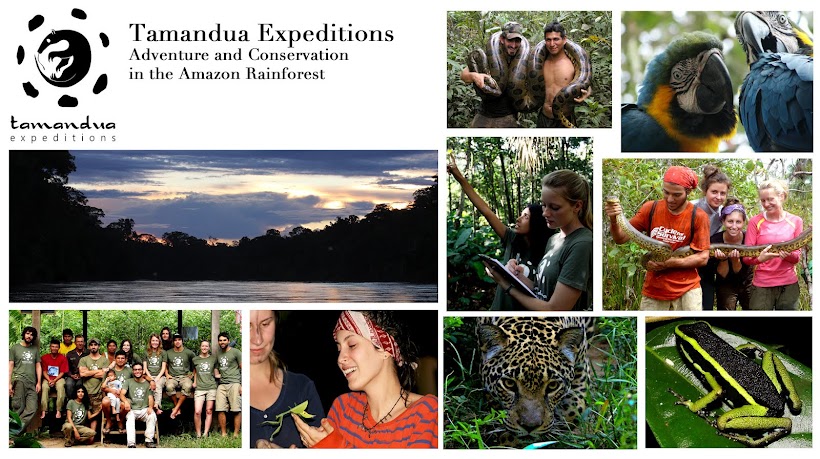A Volunteer's Account of an Expeditoins First Night:by Norm Rasmussen
"It was a two day, up-river trip from Puerto Maldonado to a small station in the middle of the jungle. In fact, if you look on Google Maps there is no civilization around the station for miles and miles. Night one on the river happened to fall on New Years Eve (I believe, it might have been the day before). As night began to fall, we saw a steep bank with a small roof on top, peering over the grasses. We tied the boat to the shore and began to unload the boat. Our accommodations for the night were a 2-person tent under a small roof. Jungle all around us, and a steady moving river behind us, life was just as vibrant at night as it was during the day.
Going back down the boat, night had fully fallen and we all needed our head lamps to navigate. One of our expedition leaders, Paul, was standing on the bow of the boat and called me over. Leaning forward, he was looking along the bank of the river at something. A small mist began to fall from the sky. “What is it?” I said to him. “There, you see those two red dots off in the distance?” he responded. I switched the setting on my headlamp to give myself a little more light and peered off into the distance. And there I saw it. About 20-30 feet in front of the boat, under some branches and leaves, two little red dots floated among the murky water. “Yeah, I see that, what is it?” He turned to me and smiled, “Croc eyes. No more than a couple feet long. C'mon lets go.”
'Let's go?' I thought to myself. But before I could finish the thought, Paul was in his boxers sitting on the side of the boat explaining that I have to get into the water slowly so as not to scare the crocodile. The mist turned into a heavy drizzle as I stood there dumbfounded. I was half startled at how quickly he got into the water. The other half was startled because of how quickly he expected me to get into the water. Just his head above the water, he looked up at me. “The water is fine! Imagine your first chance to catch a croc!” Now excited by the prospect of what I was getting myself into on the first day in the Amazon jungle, my pants and shirt were off before I knew what was happening. But I guess my body made the decision and acted before my head caught up.
The brown murky water surrounded my body. It didn't smell bad, and it was surprisingly warm. But with a cold rain beginning to turn heavy, the water seemed much warmer. My boxers waved around my thighs as I used my feet to navigate the root-covered clay floor. Moving my hands and feet slowly, I carefully navigated from one bunch of roots and plants to another. We stopped often and peered along the surface of the water, making eye contact with the two glowing embers that awaited me at the end of the long light-tunnel.
At one point we lost track of it, it sensed we were there. When we thought we lost it, Paul and I were floating in the water. Each using a hand on a branch to keep somewhat buoyant, we simply floated. The rain grew heavy and now a flash of lightning lit the area around me. As the thunder cracked, I saw Paul's head lamp turn towards me. He looked at me and said, “This is pretty damn cool, huh? You are chasing crocs, in an amazon river, in the middle of a thunder storm. At night.” I smiled at his statement and looked around, appreciating how alive I felt where I was. The red eyes appeared and I was mesmerized. Lightning flashed and the rain fell. We floated off towards the glowing red embers."

Above: Norm with expedition leaders Paul and JJ, and a midsize dwarf caiman.





